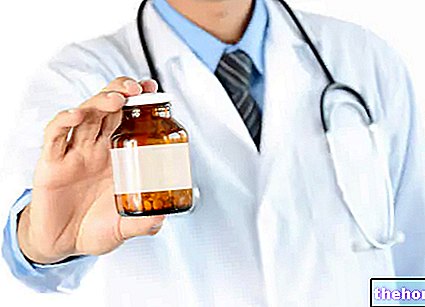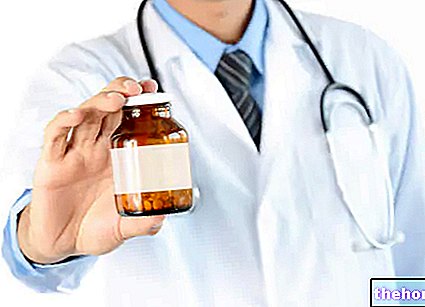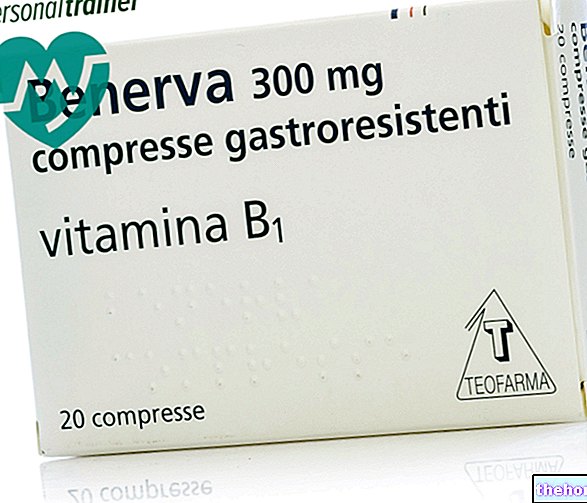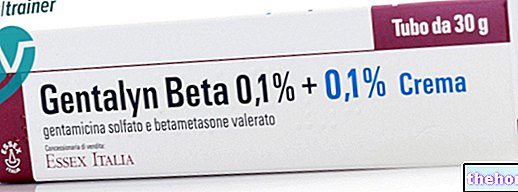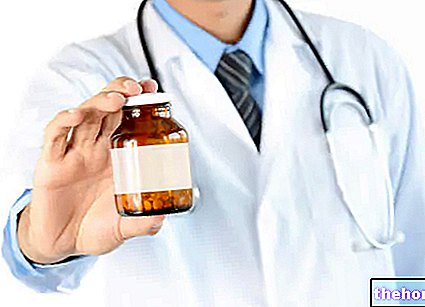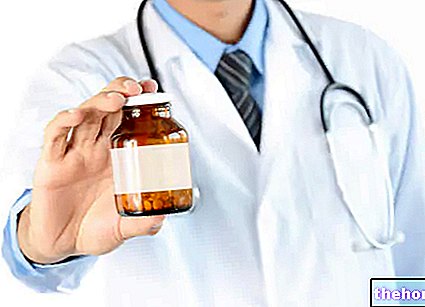Active ingredients: Amoxicillin, Clavulanic acid
ABIOCLAV 400 mg / 57 mg / 5 ml powder for oral suspension
Abioclav package inserts are available for pack sizes:- ABIOCLAV 400 mg / 57 mg / 5 ml powder for oral suspension
- ABIOCLAV 875 mg / 125 mg film-coated tablets
Why is Abioclav used? What is it for?
ABIOCLAV is an antibiotic that works by killing bacteria that cause infections. It contains two different medicines called amoxicillin and clavulanic acid. Amoxicillin belongs to a group of medicines called 'penicillins' whose activity can sometimes be blocked (made inactive).
The other active component (clavulanic acid) prevents this from happening.
ABIOCLAV is used in infants and children to treat the following infections:
- middle ear and sinus infections
- respiratory tract infections
- urinary tract infections
- skin and soft tissue infections including dental infections
- bone and joint infections
Contraindications When Abioclav should not be used
Do not give your child ABIOCLAV:
- if you are allergic (hypersensitive) to amoxicillin, clavulanic acid, penicillin or to any of the other ingredients of ABIOCLAV
- if you have ever had an allergic (hypersensitivity) reaction to any other antibiotic. This can include a skin rash or swelling of the face or neck
- if you have ever had liver problems or jaundice (yellowing of the skin) when taking an antibiotic.
Do not have your child take ABIOCLAV if any of these cases involve your child. If you are unsure, talk to your doctor or pharmacist before taking ABIOCLAV.
Precautions for use What you need to know before you take Abioclav
Talk to your doctor or pharmacist before giving this medicine to your child if:
- have infectious mononucleosis
- have been being treated for liver or kidney problems
- does not urinate regularly.
If you are not sure if any of the above applies to your child, talk to your doctor or pharmacist before taking ABIOCLAV.
In some cases, the doctor may do a "test" to assess the type of bacterium that caused your child to be infected.
Based on the results, you may be prescribed a different strength of ABIOCLAV or a different medicine.
Conditions you need to look out for
ABIOCLAV can make some existing conditions worse, or cause serious side effects. These may include allergic reactions, convulsions and inflammation of the intestine. You must look out for certain symptoms while administering ABIOCLAV to your child in order to reduce any risk. See "Conditions you need to look out for" in Section 4.
Blood and urine tests
If your child is having blood tests (such as red blood cell tests or liver function tests) or urine tests (for glucose), tell the doctor or nurse that you are taking ABIOCLAV. This is because ABIOCLAV. can affect the results of these types of tests.
Interactions Which drugs or foods can modify the effect of Abioclav
Tell your doctor or pharmacist if your child is using or has recently used any other medicines, including those available without a prescription and herbal products. If your child is taking allopurinol (used for gout) with ABIOCLAV, it is very likely that your child may have an allergic skin reaction.
If your child is taking probenecid (used for gout), the doctor may decide to change the dose of ABIOCLAV.
If you are taking medicines (such as warfarin) that help prevent blood clots from forming together with ABIOCLAV, then you may need to have additional blood tests.
ABIOCLAV can affect the way methotrexate (a medicine used to treat cancer or rheumatic diseases) works.
Warnings It is important to know that:
Pregnancy and breastfeeding
If your daughter is pregnant or breastfeeding, please tell your doctor or pharmacist.
Ask your doctor or pharmacist for advice before taking any medicine.
Important information on the excipients of ABIOCLAV
- ABIOCLAV contains aspartame (E951) which is a source of phenylalanine. It can be harmful to babies born with a disease called phenylketonuria.
Dosage and method of use How to use Abioclav: Dosage
Always give ABIOCLAV exactly as your doctor has told you. If in doubt, consult your doctor or pharmacist.
Adults and children weighing 40 kg or more
- This suspension is not recommended for adults and children weighing 40 kg or more.
If in doubt, consult your doctor or pharmacist.
Children weighing less than 40 kg
All doses are calculated on the basis of the child's body weight in kilograms. Your doctor will advise you on the dose of ABIOCLAV to give to your baby or child.
- You must use the measuring spoon contained in the package. You will use it to give your baby or child the right dose.
- Usual dose - 25 mg / 3.6 mg up to 45 mg / 6.4 mg per kg of body weight per day, given in two successive doses.
- Higher dose - up to 70 mg / 10 mg per kg of body weight per day, given in two successive doses.
Patients with kidney and liver problems
- If your child has kidney problems, the dose may be lower. Your doctor may choose a different strength or a different medicine.
- If your child has liver problems, they may have more frequent blood tests to check how their liver is working.
How to give ABIOCLAV
- Always shake the bottle before withdrawing each single dose
- Administer the dose at the start of the meal or just before
- Space the doses evenly throughout the day, at least 4 hours apart. Do not have 2 doses taken in 1 hour.
- Do not give your child ABIOCLAV for more than 2 weeks. If your child feels unwell, he should go back to the doctor.
- Before administration, you must prepare the suspension by adding water to the contents of the bottle, up to the level mark shown on the bottle label. You must shake well and leave to rest for a few minutes. Therefore, since the preparation of the suspension involves a reduction in volume, you must make a further addition of water until the level mark is reached again.
If you forget to take ABIOCLAV
If you forget to give your child a dose, give it to him as soon as he remembers. You should not give your child the next dose too soon, but wait about 4 hours before taking the next dose.
If your child stops taking ABIOCLAV
Continue to give your child ABIOCLAV until the treatment is finished, even if he seems to be better. Your child needs every dose to fight the infection. If some bacteria survive, they can cause the infection to come back.
If you have any further questions on the use of this product, ask your doctor or pharmacist.
Overdose What to do if you have taken too much Abioclav
If your child takes too much ABIOCLAV, the signs may include upset stomach (nausea, vomiting or diarrhea) or convulsions. Talk to your doctor as soon as possible. Bring the medicine pack or bottle to show to the doctor.
Side Effects What are the side effects of Abioclav
Like all medicines, ABIOCLAV can cause side effects, although not everybody gets them.
Conditions you need to look out for
Allergic reactions:
- skin rashes
- inflammation of blood vessels (vasculitis) which may be visible as red or purple spots on the skin, but which can affect other parts of the body
- fever, joint pain, swollen glands in the neck, armpits or groin
- swelling, sometimes of the face or mouth (angioedema), causing difficulty in breathing
- collapse.
Contact your doctor immediately if your child has any of these symptoms. Stop giving him ABIOCLAV.
Intestinal inflammation
Inflammation of the gut, which causes watery diarrhea usually with blood and mucus, stomach pain and / or fever.
If your child has these symptoms, contact your doctor as soon as possible for advice.
Very common side effects
They may affect more than 1 in 10 people
- diarrhea (in adults).
Common side effects
They may affect up to 1 in 10 people
- thrush (candida - a "yeast infection of the vagina, mouth or skin folds)
- nausea, especially when taking high doses: if you suffer from this, take ABIOCLAV before food
- He retched
- diarrhea (in children).
Uncommon side effects
They may affect up to 1 in 100 people
- rash, itching
- raised, itchy rash (hives)
- indigestion
- dizziness
- headache.
Uncommon side effects may show up in blood tests:
- increase in some proteins (enzymes) produced by the liver.
Rare side effects
They may affect up to 1 in 1,000 people
- rash, which may appear as blisters and look like small targets (central dark spot surrounded by a "paler" area, with a dark ring around the edge - erythema multiforme)
if you notice any of these symptoms contact your doctor urgently.
Rare side effects may show up in blood tests:
- low number of cells involved in blood clotting
- low white blood cell count
Other side effects
Other side effects occur in a very limited number of people, but their exact frequency is not known.
- Allergic reactions (see above)
- Inflammation of the intestine (see above)
- Severe skin reactions:
- a widespread rash with blisters and peeling of the skin, particularly around the mouth, nose, eyes and genitals (Stevens-Johnson syndrome), and a more severe form, causing extensive peeling of the skin (more than 30% of the body - toxic epidermal necrolysis)
- widespread red rash with small pus-containing blisters (bullous exfoliative dermatitis)
- a rash, red, with scabs and bumps under the skin and blisters (pustular rash).
If your child has any of these symptoms, contact your doctor immediately
- inflammation of the liver (hepatitis)
- jaundice, caused by an increase in the blood of bilirubin (a substance produced in the liver) which may make the skin and whites of the eyes appear yellow
- inflammation of the kidney tubules
- blood takes longer to clot
- hyperactivity
- seizures (in people taking high doses of ABIOCLAV or who have kidney problems)
- black tongue that appears covered with hair
- stains on the teeth (in children), usually removed by brushing.
Side effects that may show up in blood or urine tests:
- severe reduction in the number of white blood cells
- low number of red blood cells (haemolytic anemia)
- crystals in the urine.
If your child has side effects
If any of the side effects gets serious or bothersome, or if you notice any side effects not listed in this leaflet, please tell your doctor or pharmacist.
Expiry and Retention
After reconstitution, store the bottle at 2-8 ° C (in the refrigerator) for up to 7 days. After this period, the unadministered medicinal product should be discarded.
Keep out of the reach and sight of children.
Do not use ABIOCLAV after the expiry date which is stated on the package. The expiry date refers to the last day of the month.
Medicines should not be disposed of via wastewater or household waste. Ask your pharmacist how to dispose of medicines you no longer use. This will help protect the environment.
Other information
What ABIOCLAV contains
ABIOCLAV 400 mg / 57 mg / 5 ml powder for oral suspension
- 5 ml of suspension contain:
- Active ingredients: amoxicillin trihydrate corresponding to amoxicillin 400 mg; potassium clavulanate corresponding to clavulanic acid 57 mg.
- Excipients: lemon flavor powder, peach apricot powder flavor, anhydrous citric acid, anhydrous trisodium citrate, aspartame, talc, orange powder flavor, galactomannan guar, colloidal silica.
Description of the appearance of ABIOCLAV and contents of the pack
Powder for oral suspension - Bottle of 70 ml of reconstituted suspension of 400 mg amoxicillin / 57 mg clavulanic acid / 5 ml, with measuring spoon.
Behavioral hygiene
Antibiotics are used for the treatment of bacterial infections. They are not effective for viral infections.
Sometimes an infection caused by bacteria does not respond to antibiotic therapy. The most common reason this happens is that the bacteria causing the infection are resistant to the antibiotic that is being used. This means that the bacteria survive and settle down. they multiply despite the antibiotic.
Bacteria become resistant to antibiotics for several reasons. Using antibiotics appropriately can reduce the onset of resistance to bacteria.
When your doctor prescribes antibiotic therapy, it is only indicated for the current illness. Pay attention to the following tips, in order to avoid the emergence of bacterial resistance that causes the blocking of antibiotic activity.
- It is very important that you take the antibiotic at the right dose, at the right times and for the right number of days. Read the instructions in the package leaflet and if you are not clear about anything, ask your doctor or pharmacist about it.
- Do not take antibiotics unless they have been specifically prescribed for you and use them only for the infection for which they were prescribed.
- Do not use antibiotics that other people have been prescribed even if you have an infection similar to theirs
- Do not give the antibiotics that have been specifically prescribed for you to others
- If you have any antibiotic left over at the end of your treatment, return it to your pharmacist so that it can be disposed of properly.
Source Package Leaflet: AIFA (Italian Medicines Agency). Content published in January 2016. The information present may not be up-to-date.
To have access to the most up-to-date version, it is advisable to access the AIFA (Italian Medicines Agency) website. Disclaimer and useful information.
01.0 NAME OF THE MEDICINAL PRODUCT
ABIOCLAV
02.0 QUALITATIVE AND QUANTITATIVE COMPOSITION
ABIOCLAV 875 mg + 125 mg film-coated tablets
Each tablet contains:
Active principles: amoxicillin trihydrate corresponding to amoxicillin 875 mg, potassium clavulanate
corresponding to clavulanic acid 125 mg.
ABIOCLAV 400 mg + 57 mg / 5 ml powder for oral suspension
5 ml of suspension contain:
Active principles: amoxicillin trihydrate corresponding to amoxicillin 400 mg, potassium clavulanate corresponding to clavulanic acid 57 mg.
Excipients with known effects: aspartame.
For the full list of excipients, see section 6.1.
03.0 PHARMACEUTICAL FORM
875 mg + 125 mg film-coated tablets
Film-coated tablet
400 mg + 57 mg / 5 ml powder for oral suspension
Powder for oral suspension
04.0 CLINICAL INFORMATION
04.1 Therapeutic indications
ABIOCLAV is indicated for the treatment of the following infections in adults and children (see sections 4.2, 4.4 and 5.1):
• Acute bacterial sinusitis (adequately diagnosed)
• Acute otitis media
• Acute exacerbations of chronic bronchitis (adequately diagnosed)
• Community-acquired pneumonia
• Cystitis
• Pyelonephritis
• Skin and soft tissue infections especially cellulitis, animal bites, severe dental abscess with widespread cellulitis
• Bone and joint infections, especially osteomyelitis.
Official guidelines on the appropriate use of antibacterial agents should be considered.
04.2 Posology and method of administration
Doses are expressed in terms of amoxicillin / clavulanic acid content except when doses are defined in terms of a single component.
The dose of ABIOCLAV that is chosen for the treatment of each individual infection should take into account:
• Expected pathogens and their likely susceptibility to antibacterial agents (see section 4.4)
• Severity and site of infection
• Patient age, weight and renal function, as described below.
The use of alternative amoxicillin / clavulanic acid formulations (eg those providing higher doses of amoxicillin and / or different amoxicillin-clavulanic acid ratios) should be considered as necessary (see sections 4.4 and 5.1).
For adults and children weighing ≥ 40 kg this formulation of ABIOCLAV provides a total daily dose of 1750 mg amoxicillin / 250 mg clavulanic acid twice daily and 2625 mg amoxicillin / 375 mg clavulanic acid for the dosage three times a day, when given as recommended below. For children of weight
The duration of therapy should be defined based on the patient's response. Some infections (e.g. osteomyelitis) require longer treatment periods. Treatment should not be continued beyond 14 days without medical supervision (see section 4.4 regarding prolonged therapy).
Adults and children weighing ≥ 40 kg
Recommended doses:
• standard dose: (for all indications) 875 mg / 125 mg twice daily.
• higher dose: (particularly for infections such as otitis media, sinusitis, lower respiratory tract infections and urinary tract infections): 875 mg / 125 mg three times a day.
Weight children
It is recommended that children be treated with amoxicillin / clavulanic acid tablets, suspension or pediatric sachets.
Recommended doses:
• 25 mg / 3.6 mg / kg / day to 45 mg / 6.4 mg / kg per day taken in two divided doses;
• up to 70 mg / 10 mg / kg / day in two divided doses may be considered for some infections (such as otitis media, sinusitis and lower respiratory tract infections).
No clinical data are available for the 7: 1 formulations of ABIOCLAV relating to doses greater than 45 mg / 6.4 mg per kg per day in children less than 2 years of age.
No clinical data are available for ABIOCLAV 7: 1 formulations in children less than 2 months of age. Therefore, no dosage recommendations can be made in this population.
Senior citizens
No dosage adjustment is considered necessary.
Kidney failure
No dose adjustment is required in patients with creatinine clearance (CrCl) greater than 30 mL / min.
In patients with creatinine clearance below 30 mL / min, there is no recommendation for the use of ABIOCLAV formulations with an amoxicillin / clavulanic acid ratio of 7: 1, as no dosage adjustments are available.
Hepatic insufficiency
Dose with caution and monitor liver function at regular intervals (see sections 4.3 and 4.4).
Method of administration
ABIOCLAV is for oral use.
Administer at the start of a meal to minimize potential gastrointestinal intolerance and optimize absorption of amoxicillin / clavulanic acid.
Therapy can be initiated parenterally according to the Summary of Product Characteristics of formulation IV and continued with an oral preparation.
400 mg + 57 mg / 5 ml powder for oral suspension
Shake the powder, add water as directed, invert and shake.
Shake the bottle before taking each dose (see section 6.6)
04.3 Contraindications
Hypersensitivity to the active substance, to any penicillin or to any of the excipients listed in section 6.1.
History of severe immediate hypersensitivity reactions (e.g. anaphylaxis) to other beta-lactam agents (e.g. cephalosporins, carbapenems or monobactams).
History of jaundice / hepatic failure due to amoxicillin / clavulanic acid (see section 4.8).
04.4 Special warnings and appropriate precautions for use
Before initiating therapy with ABIOCLAV, a thorough investigation of previous hypersensitivity reactions to penicillins, cephalosporins or other beta-lactam agents should be conducted (see sections 4.3 and 4.8).
Severe and occasionally fatal hypersensitivity reactions (anaphylactoid reactions) have been reported in patients receiving penicillin. These reactions are more likely to occur in individuals with a history of penicillin hypersensitivity and in atopic individuals. If an allergic reaction occurs, amoxicillin / clavulanic acid therapy should be discontinued and appropriate alternative therapy instituted.
If an infection is proven to be due to an amoxicillin-susceptible organism, a change of therapy from amoxicillin / clavulanic acid to amoxicillin in accordance with official guidelines should be considered.
This formulation of ABIOCLAV is not suitable for use where there is a high risk that the presumed pathogens have a reduced susceptibility or resistance to beta-lactam agents, not mediated by beta-lactamases susceptible to inhibition by clavulanic acid. This formulation should not be used for treating S. pneumonia penicillin-resistant.
Convulsions may occur in patients with impaired renal function or in those receiving high doses (see section 4.8).
The administration of amoxicillin / clavulanic acid should be avoided if infectious mononucleosis is suspected, as the use of amoxicillin has been associated with the onset of morbilliform rash in this condition.
Concomitant use of allopurinol during treatment with amoxicillin may increase the likelihood of allergic skin reactions.
Prolonged use may occasionally cause the development of resistant organisms.
The appearance of generalized erythema with pustules caused by fever during the initial phase of treatment may be a symptom of acute generalized exanthematous pustulosis (AGEP) (see section 4.8). This reaction requires a suspension of ABIOCLAV and any subsequent administration of amoxicillin is contraindicated.
Amoxicillin / clavulanic acid should be used with caution in patients with evident hepatic impairment (see sections 4.2, 4.3 and 4.8).
Hepatic events have been reported particularly in male and elderly patients and may be associated with prolonged treatment. These events have rarely been reported in children. In all populations, signs and symptoms generally occur during or soon after treatment but in some cases they may be evident only several weeks after stopping treatment. These events are usually reversible. Hepatic events can be severe and, in extremely rare circumstances, deaths have been reported, which almost always occurred in patients with pre-existing serious illness or who were taking drugs known to have potential hepatic effects (see section 4.8).
Antibiotic-associated colitis has been reported with almost all antibacterial agents and can be mild to life-threatening in severity (see section 4.8). Therefore, it is important to consider this diagnosis in patients who present with diarrhea during or after the administration of any antibiotic. Should antibiotic-associated colitis occur, amoxicillin / clavulanic acid should be discontinued immediately, a physician consulted and appropriate therapy initiated. In this situation, peristaltic drugs are contraindicated.
During prolonged therapy, it is advisable to periodically check systemic-organic function, including renal, hepatic and haematopoietic function.
Prolongation of prothrombin time has been reported rarely in patients receiving amoxicillin / clavulanic acid. Appropriate monitoring should be performed in the case of concomitant administration of anticoagulants. Dose adjustments of oral anticoagulants may be required to maintain the desired level of anticoagulation (see sections 4.5 and 4.8).
In patients with renal insufficiency, the dosage should be adjusted according to the degree of insufficiency (see section 4.2).
In patients with reduced urine output, crystalluria has been observed very rarely, especially with parenteral therapy. During the administration of high doses of amoxicillin, it is advisable to maintain adequate fluid intake and urine output in order to reduce the possibility of amoxicillin crystalluria. In patients with bladder catheters, regular control of patency should be maintained (see section 4.9).
During treatment with amoxicillin, enzymatic methods with glucose oxidase should be used whenever testing for the presence of glucose in urine as false positive results may occur with non-enzymatic methods.
The presence of clavulanic acid in ABIOCLAV can cause non-specific binding of IgG and albumin by the red blood cell membranes, leading to a false positive in the Coombs test.
Positive test results have been reported using the Bio-Rad Laboratories Platelia test Aspergillus EIA in patients receiving amoxicillin / clavulanic acid and who were consequently found free of Aspergillus. With the Bio-Rad Laboratories Platelia test Aspergillus EIA, cross reactions with non-polysaccharides have been reported-Aspergillus and polyphuranose. Therefore positive test results in patients receiving amoxicillin / clavulanic acid should be interpreted with caution and confirmed by other diagnostic methods.
ABIOCLAV 400 mg + 57 mg / 5 ml powder for oral suspension contains 1.7 mg of aspartame (E951) per ml, which is a source of phenylalanine. This medicine should be used with caution in patients with phenylketonuria.
04.5 Interactions with other medicinal products and other forms of interaction
Oral anticoagulants
Oral anticoagulants and penicillins have been widely used in clinical practice with no reports of interactions. However, in the literature there are cases of increased international normalized ratio in patients maintained on acenocoumarol or warfarin, who were prescribed treatment with amoxicillin. If co-administration is necessary, prothrombin time or international normalized ratio should be carefully monitored in case of addition or withdrawal of amoxicillin. In addition, dose adjustments of oral anticoagulants may be required (see sections 4.4 and 4.8).
Methotrexate
Penicillins can reduce the excretion of methotrexate, causing a potential increase in toxicity.
Probenecid
Concomitant use of probenecid is not recommended. Probenecid reduces renal tubular secretion of amoxicillin. Concomitant use of probenecid may result in a prolonged increase in blood levels of amoxicillin but not of clavulanic acid.
Mycophenolate mofetil
In patients treated with mycophenolate mofetil, following the initiation of treatment with amoxicillin and oral clavulanic acid, there was a reduction of the pre-dose concentration of mycophenolic acid active metabolite (MPA) by approximately 50%. -dose may not accurately represent changes in overall MPA exposure. Therefore, a change in mycophenolate mofetil dose should not normally be necessary in the absence of clinical signs of graft dysfunction. However, close clinical monitoring should be performed during the combination and immediately after antibiotic treatment.
04.6 Pregnancy and breastfeeding
Pregnancy
Animal studies do not indicate direct or indirect harmful effects with respect to pregnancy, embryonal / fetal development, parturition or postnatal development (see section 5.3). Limited data on the use of amoxicillin / clavulanic acid during pregnancy in humans does not indicate an increased risk of congenital malformations. In a single study in women with premature, preterm, fetal membrane rupture, prophylactic treatment with amoxicillin / clavulanic acid may be associated with an increased risk of necrotizing enterocolitis in neonates. Use in pregnancy should be avoided unless considered essential by the physician.
Feeding time
Both substances are excreted in breast milk (the effects of clavulanic acid on the nursing infant are not known). As a result, diarrhea and fungal mucosal infections are possible in the nursing infant, so that breastfeeding must be discontinued. . Amoxicillin / clavulanic acid should only be administered during the lactation period after the risk / benefit has been evaluated by the physician.
04.7 Effects on ability to drive and use machines
No studies on the ability to drive and use machines have been performed. However, undesirable effects (eg allergic reactions, dizziness, convulsions) may occur which may affect the ability to drive and use machines (see section 4.8). .
04.8 Undesirable effects
The most commonly reported adverse reactions (ADRs) are diarrhea, nausea and vomiting.
The ADRs from clinical studies and post-marketing investigations with ABIOCLAV are reported below according to the MedDRA classification for Systems and Organs.
The following terminology has been used to rank the frequency of undesirable effects.
Very common (≥1 / 10)
Common (≥1 / 100 to
Uncommon (≥1 / 1,000 to
Rare (≥1 / 10,000 to
Very rare (
Not known (cannot be estimated from the available data)
Reporting of suspected adverse reactions
Reporting of suspected adverse reactions occurring after authorization of the medicinal product is important as it allows continuous monitoring of the benefit / risk balance of the medicinal product. Healthcare professionals are asked to report any suspected adverse reactions via the national reporting system. "address www.agenziafarmaco.gov.it/it/responsabili.
04.9 Overdose
Symptoms and signs of overdose
Gastrointestinal symptoms and disturbances in water and electrolyte balance may be evident. Amoxicillin crystalluria, in some cases leading to renal failure, has been observed (see section 4.4).
Convulsions can occur in patients with impaired renal function or in patients receiving high doses.
Precipitation of amoxicillin in bladder catheters has been reported, predominantly after intravenous administration of large doses. Regular control of patency should be maintained (see section 4.4).
Treatment of intoxication
Gastrointestinal symptoms can be treated symptomatically, with attention to water and electrolyte balance. Amoxicillin / clavulanic acid can be removed from the circulation by hemodialysis.
05.0 PHARMACOLOGICAL PROPERTIES
05.1 Pharmacodynamic properties
Pharmacotherapeutic group: combination of penicillins, including beta-lactamase inhibitors.
ATC code: J01CR02.
Mechanism of action
Amoxicillin, a semi-synthetic penicillin (beta-lactam antibiotic), inhibits one or more enzymes (often referred to as penicillin-binding proteins, PBPs) of the biosynthetic pathway of bacterial peptidoglycan, an integral structural component of the bacterial cell wall. synthesis of the peptidoglycan leads to the weakening of the structure, which is usually followed by cell lysis and bacterial death.
Amoxicillin is susceptible to degradation by beta-lactamases and therefore the spectrum of activity of amoxicillin alone does not include organisms that produce these enzymes.
Clavulanic acid is a beta-lactam structurally related to penicillins. Inactivates some beta-lactam enzymes, thereby preventing the inactivation of amoxicillin. Clavulanic acid alone does not exert a clinically useful antibacterial effect.
PK / PD relationship
The time above the minimal inhibitory concentration (T> MIC) is considered to be the major determinant of the efficacy of amoxicillin.
Mechanisms of resistance
The two main mechanisms of resistance to amoxicillin / clavulanic acid are:
• Inactivation by bacterial beta-lactamases which are not themselves inhibited by clavulanic acid, including classes B, C and D.
• Alteration of PBPs, which reduces the affinity of the antibacterial agent for the target.
Bacteria impermeability or efflux pump mechanisms can cause or contribute to bacterial resistance, particularly in Gram-negative bacteria.
Breakpoints
MIC breakpoints for amoxicillin / clavulanic acid are defined by The European Committee on Antimicrobial Susceptibility Testing (EUCAST).
The prevalence of resistance may vary geographically and with time for selected species and local information on resistance is desirable, particularly when treating severe infections. As necessary, expert advice should be sought if the local prevalence of resistance is such that the utility of the agent in at least some types of infections is questionable.
05.2 Pharmacokinetic properties
Absorption
Amoxicillin and clavulanic acid completely dissociate in aqueous solution at physiological pH. Both components are absorbed quickly and well with the oral route of administration. Absorption of amoxicillin / clavulanic acid is optimized when taken at the start of a meal. Following oral administration, amoxicillin and clavulanic acid are approximately 70% bioavailable. The plasma profiles of both components are similar and the time to reach peak plasma concentrations (Tmax) in each case is approximately one "hour.
Pharmacokinetic results from separate studies are presented below, in which amoxicillin / clavulanic acid (875/125 mg tablets administered twice daily) was administered in the fasted state to groups of healthy volunteers.
The serum concentrations of amoxicillin and clavulanic acid achieved with amoxicillin / clavulanic acid are similar to those produced by oral administration of equivalent doses of amoxicillin and clavulanic acid alone.
Distribution
About 25% of clavulanic acid in plasma and 18% of amoxicillin is bound to proteins. The apparent volume of distribution is around 0.3-0.4 l / kg for amoxicillin and around 0.2 l / kg for clavulanic acid.
Following intravenous administration, amoxicillin and clavulanic acid have been found in the gallbladder, abdominal tissue, skin, fat, muscle tissue, synovial and peritoneal fluid, bile and pus. Amoxicillin is not adequately distributed in the cerebrospinal fluid.
Animal studies show no significant tissue retention of drug-derived material of either component. Amoxicillin, like most penicillins, can be detected in breast milk. Traces of clavulanic acid may be detected in breast milk (see section 4.6).
Both amoxicillin and clavulanic acid have been shown to cross the placental barrier (see section 4.6).
Biotransformation
Amoxicillin is partially excreted in the urine as inactive penicilloic acid in amounts equivalent to up to 10-25% of the initial dose. Clavulanic acid is extensively metabolised in humans, and eliminated in the urine and faeces, and as dioxide of carbon in the exhaled air.
Elimination
The major route of elimination for amoxicillin is via the kidney, while for clavulanic acid it is via both renal and non-renal mechanisms.
Amoxicillin / clavulanic acid has a mean elimination half-life of approximately one hour and a mean total clearance of approximately 25 L / hour in healthy subjects. Approximately 60-70% of amoxicillin and approximately 40-65% of "Clavulanic acid is excreted unchanged in the urine during the first 6 hours following the administration of a single 250 mg / 125 mg or 500 mg / 125 mg amoxicillin / clavulanic acid tablet. Several studies have found that urinary excretion was low. 50-85% for amoxicillin and between 27-60% for clavulanic acid over a 24 hour period. In the case of clavulanic acid, the greatest amount of drug is excreted during the first 2 hours following administration.
Concomitant use of probenecid delays the excretion of amoxicillin but does not delay the renal excretion of clavulanic acid (see section 4.5).
Age
The elimination half-life of amoxicillin is similar in children aged approximately 3 months to 2 years, older children and adults. In very young infants (including those born preterm) in the first week of life the dosing interval should not exceed two doses per day due to immaturity of the renal elimination system. As elderly patients are more likely to have decreased renal function, it may be useful to monitor renal function.
Type
Following oral administration of amoxicillin / clavulanic acid to healthy male and female subjects, gender has no significant impact on the pharmacokinetics of either amoxicillin or clavulanic acid.
Kidney failure
Total serum clearance of amoxicillin / clavulanic acid decreases proportionally with decreased renal function. The reduction in drug clearance is more pronounced for amoxicillin than for clavulanic acid, as more amoxicillin is excreted via the kidney. Therefore, the posology in renal insufficiency should prevent excessive accumulation of amoxicillin by maintaining adequate levels of clavulanic acid (see section 4.2).
Hepatic insufficiency
Patients with hepatic insufficiency should be dosed with caution and liver function monitored at regular intervals.
05.3 Preclinical safety data
Non-clinical data reveal no particular risk for humans based on safety pharmacology, genotoxicity and reproductive toxicity studies.
Repeat dose toxicity studies with amoxicillin / clavulanic acid in dogs demonstrated gastric irritation and vomiting, and discolouration of the tongue.
Carcinogenicity studies have not been conducted with ABIOCLAV or its components.
06.0 PHARMACEUTICAL INFORMATION
06.1 Excipients
ABIOCLAV 875 mg + 125 mg film-coated tablets
Colloidal anhydrous silica, magnesium stearate, talc, povidone (K25), croscarmellose sodium, microcrystalline cellulose
Film: triethyl citrate, ethyl cellulose aqueous dispersion, hypromellose, talc, titanium dioxide
ABIOCLAV 400 mg + 57 mg / 5 ml powder for oral suspension
Lemon flavor powder, peach apricot powder flavor, anhydrous citric acid, anhydrous trisodium citrate, aspartame, talc, orange powder flavor, galactomannan guar, colloidal silica
06.2 Incompatibility
No known incompatibilities.
06.3 Period of validity
With intact packaging:
Film-coated tablets: 2 years.
Powder for oral suspension: 3 years.
06.4 Special precautions for storage
With intact packaging
Film-coated tablets and powder for oral suspension
Store at a temperature not exceeding 25 ° C in the original packaging to protect the product from light and humidity.
Powder for oral suspension: after reconstitution store the bottle at 2 - 8 ° C (in the refrigerator) for up to 7 days. After this period, the unadministered medicinal product should be discarded.
06.5 Nature of the immediate packaging and contents of the package
ABIOCLAV 875 mg + 125 mg Film-coated tablets - 12 tablets
Aluminum / Polyethylene coupled blister
ABIOCLAV 400 mg + 57 mg / 5 ml powder for oral suspension - 70 ml bottle
Amber glass bottle with child-proof closure and measuring spoon with a notch at 1.25ml, 2.5ml and 5ml.
06.6 Instructions for use and handling
No special instructions for disposal.
Unused medicine and wastes derived from this medicine must be disposed of in accordance with local regulations.
400 mg + 57 mg / 5 ml powder for oral suspension
Before use, check that the seal on the cap is intact. Shake the bottle to dissolve the powder. Add the volume of water (as indicated below), invert and shake well. Alternatively, fill the bottle with water just below the level shown on the bottle label, invert and shake well. Then fill with water exactly to the level, invert and shake well again.
Shake the bottle well before taking each dose.
875 mg + 125 mg film-coated tablets
In order to facilitate swallowing, the tablets can be divided but should be taken immediately.
07.0 MARKETING AUTHORIZATION HOLDER
Aesculapius Farmaceutici S.r.l. - Via Cozzaglio, 24-25125 Brescia
08.0 MARKETING AUTHORIZATION NUMBER
ABIOCLAV 875 mg + 125 mg film-coated tablets - 12 tablets
AIC n. 037350016
ABIOCLAV 400 mg + 57 mg / 5 ml powder for oral suspension - 70 ml bottle with measuring spoon
AIC n. 037350028
09.0 DATE OF FIRST AUTHORIZATION OR RENEWAL OF THE AUTHORIZATION
July 2009 / October 2014
10.0 DATE OF REVISION OF THE TEXT
October 2014

